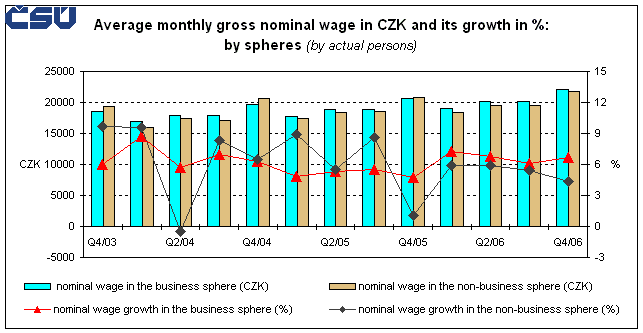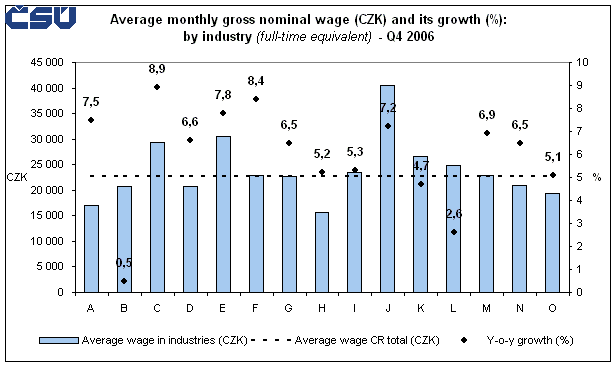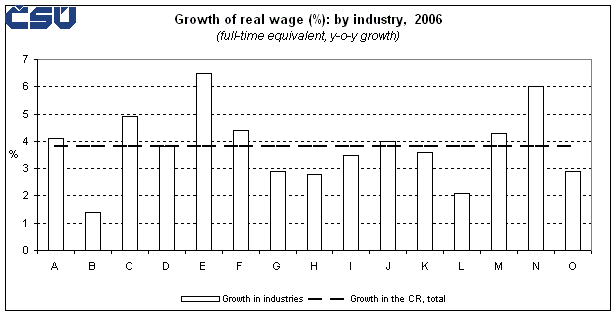Analysis of the development of average wages of employees - 4. quarter of 2006
Product Code: e-3134-06
Analysis of the development of average wages of employees
In Q4 2006, the average gross monthly nominal wage per actual person reached CZK 21 952; in the year-on-year comparison the increment was CZK 1 283.
In the business sphere the average wage increased year-on-year by CZK 1 390 to CZK 22 021, while in the non-business sphere it went up by CZK 912 to CZK 21 712. The relative increase of the average wage was 6.2%, the growth in the business sphere being 6.7% and in the non-business sphere 4.4%. In the same period, consumer prices went up by 1.5% and the real wage thus rose by 4.6% in total, in the business sphere by 5.1% and in the non-business sphere by 2.9%. The minimal wage was increased two times in the year 2006, namely on 1 January 2006 and on 1 July 2006, always by CZK 385 to CZK 7 955 in the second half-year of 2006, when its y-o-y increase was 10.7%.
In 2006, the average wage was CZK 20 211, which compared to 2005 is an increase of CZK 1 226, i.e. 6.5%. Consumer prices increased by 2.5% in the same period, the growth of the real wage was 3.9%.
The relative year-on-year increment of the average nominal wage for Q4 2006 (6.2%) appears to be as below the average compared to the three previous quarters of 2006 (6.5%), while from the point of view of a medium-term comparison (comparison with the average for 8 preceding quarters – 5.9%) it is above the average. The results for 2006 (6.5%) suggest that from the long-term comparison it concerns a slightly below the average increment (the average annual increase for the previous five years was 6.9%). However, we have to be aware that in 2001 and 2002 the year-on-year increment was about 7-9%, in the following two years a drop to 6.6% occurred and in 2005 it even dropped to 5.2%. It therefore means that following several years of deceleration of the wage growth in 2006 a turn towards its acceleration occurred. (Graph 1).
Graph 1

As for the real wage, the situation is somewhat different, because its development is affected by a co-influence of two factors. Together with the nominal wage growth there is also an increase of the price level (inflation) expressed by the consumer price index (CPI). During the period of 2001 to 2006, the CPI was rather markedly fluctuating moving in between 4.7% in 2001 to 0.1% in 2003. Thus, in 2003, due to a very low inflation, the highest growth of the real wage was recorded. While the current relative increment of nominal wages is on the level of the year 2003, the real wage increased by 3.9% year-on-year in 2006; in 2003 it was (namely due to the influence of the low inflation) 6.5% (see Graph 1, more detailed information on /produkty/pmz_cr).
Nationwide wage development is heavily shaped primarily by the business sphere as employees of this sphere account for more than three quarters of the set of units under observation. While the wage development in the business sphere is more fluent and is affected primarily by economic results of the companies, it is jump-like in nature in the non-business sphere because it depends to a large extent on legislative measures of the government and on what is permitted by the budget.
In previous years, wage differences between the business and non-business spheres usually became wider always in Q1 and Q3 of a given year, i.e. the average wage in the business sphere was higher than in the non-business. In Q2 and Q4, the average wage levels then mostly converged, owing to half or a certain part of the additional salary regularly paid in the non-business sphere. In some periods the wage level in the non-business sphere exceeded the one in the business sphere. Nominal wage development and its relative increments by sphere are shown in Graph 2.
In 2005, the wage development in the non-business sphere was influenced by adjustments to salaries and wages of employees in public services and administration. Apart from the normal year-on-year rise in average salaries, salaries in selected professions rose in a differentiated way. The Government Regulation No. 637/2004 Sb. and No. 307/2005 Sb. extended the circle of employees whose wage rates are provided according to the scale of increased wage rates (e.g. employees providing social care directly, employees in charge of administrative social care services, employees engaged in work on roads, collection and processing of municipal waste, and health personnel). Furthermore, a new scale of increased wage rates was put in place for employees – members of the Police of the CR, the Prison Service of the CR, the Fire and Rescue Service of the CR, and the Customs Administration of the CR. On 1 January 2005, the payment of the additional salaries was cancelled in the non-business sphere. The latest wage adjustment in particular helped suppress rather large differences in the wage levels between individual quarters in the non-business sphere. The wage development in this sphere therefore becomes smoother, with possible jumps caused to happen in response to legislative measures only. The given fact is documented by Graph 2 – since 2005 no marked drops of the absolute level of average wage occurred in the non-business sphere, in particular in Q3 (in Q1 the wage is regularly lower even in the business sphere). Concerning the relative year-on-year increments, the first from this point of view comparable period in the non-business sphere was year 2006, when results of individual quarters confirmed the expectations that there is going to be a wage development without marked fluctuations in this sphere.
Graph 2

Given the fact that the non-business sphere employs a higher proportion of part-time workers than the business one, the following comparisons are made with average wage data related to full-time equivalent (FTE) employees as these data take account of the length of work.
Differences in the wage level and in its growth rate between industries (CZ-NACE sections) are well characterized by Graph 3. The graph suggests that the lowest wage level in Q4 2006 existed in ‘hotels and restaurants‘ (CZK 15 730); ‘agriculture, hunting and forestry’, ‘other community, social, and personal service activities’. On the other hand the highest wage level was reached in ‘financial intermediation‘ (CZK 40 466), ‘electricity, gas and water supply‘, and ‘mining and quarrying‘. Although relative year-on-year increments for industries from the opposite ends of the scale represent only 2 percentage points (‘hotels and restaurants ‘ 5.2%; ‘financial intermediation‘ 7.2%), it has to be realized that a relative growth in low nominal wage categories represents an increase of the average of about CZK 800, while a growth in high nominal wage categories represents an increase of the average by more than CZK 2.7 thousand.
Graph 3

| A | Agriculture, hunting and forestry | B | Fishing | |
| C | Mining and quarrying | D | Manufacturing | |
| E | Electricity, gas and water supply | F | Construction | |
| G | Wholesale and retail trade; repair of motor vehicles, motorcycles and personal and household goods | H | Hotels and restaurants | |
| I | Transport, storage and communications | J | Financial intermediation | |
| K | Real estate, renting and business activities | L | Public administration and defence; compulsory social security | |
| M | Education | N | Health and social work | |
| O | Other community, social and personal service activities |
In 2006, the average wage per FTE person increased by CZK 1 261 year-on-year (+6.4%) and reached CZK 20 844, rising to CZK 20 808 (+6.7%, CZK +1 306) in the business sphere and CZK 20 975 (+5.5%, CZK +1 100) in the non-business sphere. The real wage increased by 3.8% in total, in the business sphere by 4.1% and by 2.9% in the non-business sphere. While in the results for individual quarters, the average wage exceeded CZK 20 thousand several times, in the total data for the whole year this happened for the first time and we can expect that the wage per FTE persons will not drop below this level even in the following quarters. On the other hand it is necessary to be aware of the fact that according to the results of structural statistics, when data on earnings of individual employees are available, approximately two thirds of them have wage lower than the national average.
When comparing the wage development in 2006 in industries made at the CZ-NACE division level (more detailed classification on the level of a two-digit code) it is possible to note that in the long term among the three industries (employing a minimum of 20 thousand people and excluding enterprises with less than 20 employees) with the lowest average nominal wage per FTE person:
- manufacture of wearing apparel; dressing and dyeing of fur: CZK 11 334 (the average wage in this industry was approximately 54% of the national average, the nominal or relative year-on-year rise being CZK +591 or +5.5%, respectively);
- manufacture of textiles and textile products: CZK 13 975 (67% of the average, CZK +858 or +6.5%);
- hotels and restaurants: CZK 14 760 (71% of the average, CZK +750 or +5.4%).
On the other hand, the following three industries (with the same criterion in force, i.e. at least 20 thousand employees) were paying the highest average nominal wage per FTE person:
- computer and related services: CZK 45 420 (the average wage in this industry was approximately 218% of the national average, the nominal or relative year-on-year rise being CZK +2 464 or +5.7%, respectively);
- financial intermediation except for insurance and pension funding: CZK 42 892 (206% of the average, CZK +2 856 or +7.1%, respectively);
- electricity, gas, steam and hot water supply: CZK 30 027 (144% of the average, CZK +2 868 or +10.6%, respectively).
Earnings of employees in the industry (regardless the number of employees) with the highest wage (air transport – CZK 50 765) reached in 2006 about 4.5 times the wage of employees in the industry paying the lowest wage (manufacture of wearing apparel; dressing and dyeing of fur – CZK 11 334). In 2006 inter-industry wage differences slightly increased compared to 2005; the variation coefficient of average wages (by CZ-NACE division) was 0.7 percentage point up and reached 35.2% of which in Q4 2006 it increased year-on-year by 0.8 percentage points to 34.0% (per FTE persons).
The year-on-year increments of the real wage in the CZ-NACE industries (CZ-NACE sections) compared to the national average are shown in the following graph.
Graph 4

| A | Agriculture, hunting and forestry | B | Fishing | |
| C | Mining and quarrying | D | Manufacturing | |
| E | Electricity, gas and water supply | F | Construction | |
| G | Wholesale and retail trade; repair of motor vehicles, motorcycles and personal and household goods | H | Hotels and restaurants | |
| I | Transport, storage and communications | J | Financial intermediation | |
| K | Real estate, renting and business activities | L | Public administration and defence; compulsory social security | |
| M | Education | N | Health and social work | |
| O | Other community, social and personal service activities |
The average wage in enterprises and organisations, which employ 250+ employees exceeded CZK 22 thousand in 2006 ( per FTE persons), in enterprises with 50-249 employees it did not even reach CZK 20 thousand, enterprises with 20-49 employees paid nearly CZK 19 thousand. It is important to note that the quarterly statistical survey from which all of the above mentioned data are used, do not cover enterpreneurial subjects with less than 20 employees.
___________
1 The data refer to business sphere enterprises with 20+ employees (in financial intermediation irrespective of the number of employees) and all non-business sphere organizations. They only refer to employees under employment contract with reporting units. Persons performing public office, such as members of Parliament, senators, full-time councillors at all levels, judges, etc. are excluded.
